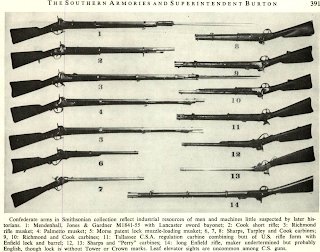Burton was a talented general engineer, it is true,
Whitney pistol ultimately built by Spiller & Burr. Regardless of the personal interest which this remarkable
Burton seems to have associated himself with potential manufacturers in an arms contract. He would then
Under government supervision, Downer estimated
Guns made by Robinson are found marked “S C.
which may be read “88—it is believed the stamps are
Though the Robinson shop represented a high degree of efficient mechanization, producing 500 carbines
Whitney pistol ultimately built by Spiller & Burr. Regardless of the personal interest which this remarkable
Burton seems to have associated himself with potential manufacturers in an arms contract. He would then
Under government supervision, Downer estimated
Guns made by Robinson are found marked “S C.
 |
J. P. Murray rifle, like Mendenhall, Jones & Gardner, is combination of M and M U.S. styles.
|
Though the Robinson shop represented a high degree of efficient mechanization, producing 500 carbines

Comments
Post a Comment